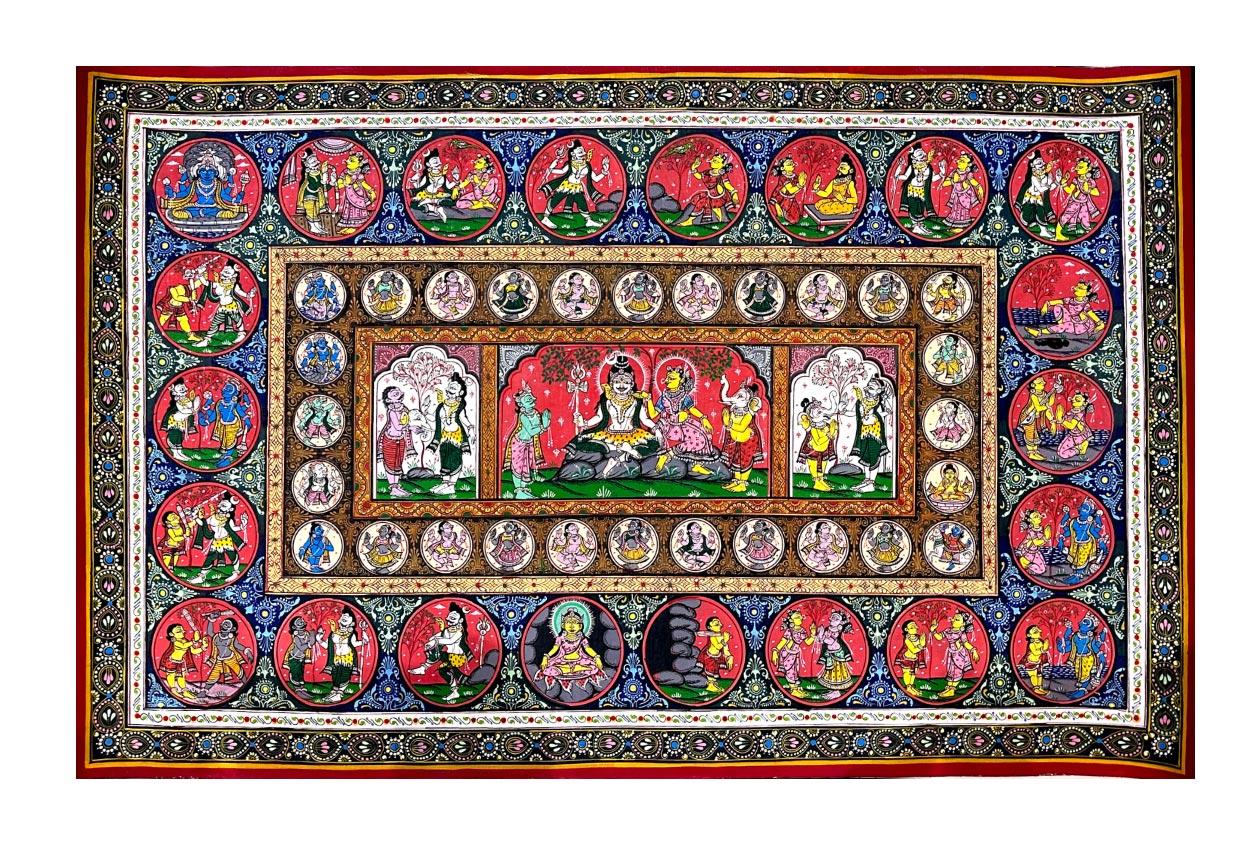Worldwide Fast & Safe Delivery | Oldest ISO 9001-2015 Certified Rudraksha Organization in the World | Your Trusted Brand Since 1997

Shopping Cart

Shiva Puran Katha Pattachitra Painting
INR 42,380
Dimension: 24 (W) x 36 (H) inches
Product Code: PPO01
Quantity:
INR 42,380
Patta' means cloth and 'Chitra' means picture in Sanskrit. Through this artistic vibrant painting, a series of kathas, folktales and narratives from the Shiv Puran has been captured beautifully. Goddess Parvati was a reincarnation of Sati. Lord Shiva was so deeply engrossed in meditation and mourning over the loss of Sati that he was not ready to even look at Goddess Parvati. This led to the intervention of Kamadeva, the God of love, who succeeded in piercing Lord Shiva's heart with an arrow of love. After being convinced by other Gods to marry Goddess Parvati, Lord Shiva decided to test her devotion.
The Saptarishis (the seven sages) approached Goddess Parvati and mocked Lord Shiva to dissuade her. However, Goddess Parvati remained resolute. Lord Shiva disguised himself as an old ascetic visited Goddess Parvati and vilified himself in her presence. Goddess Parvati was angry and was about to leave when Lord Shiva revealed his true avatar and promised to marry her since he was pleased with her love and devotion. Lord Shiva and Goddess Parvati agreed to marry each other at Triyuginarayan village while they were on their way back to meet Goddess Parvati's parents. Their marriage was solemnised in the month of Phalgun, a day before Amavasya which is celebrated as Maha Shivratri every year. Lord Brahma discharged the duties of the divine priest while Lord Vishnu was responsible for the wedding preparations.
The painting also depicts the legends associated with Lord Shiva severing the head of Lord Ganesha. One day Goddess Parvati was preparing for a bath at Mount Kailash. As she did not want to be disturbed, she asked Nandi to guard the door and let no one pass. Nandi faithfully stood there intending to carry out Goddess Parvati’s wishes. However, when Lord Shiva came home, Nandi let him pass since he was loyal first towards Lord Shiva. Goddess Parvati was angry at the fact that she had no one as loyal as Nandi was to Lord Shiva. She took turmeric paste, breathed life into it and created Lord Ganesha declaring him to be her own loyal son. Once Goddess Parvati asked Lord Ganesha to guard the door while she was bathing. In due course, Lord Shiva came home only to find Lord Ganesha blocking the entrance and denying entry to him. Furious, Lord Shiva ordered his army to destroy the boy, however they all failed. Seeing that he was no ordinary boy, the usually peaceful Lord Shiva decided that he would have to fight him. In his divine fury, he severed Lord Ganesha’s head. Goddess Parvati was enraged and threatened to destroy the entire Creation. Lord Brahma, the Creator pleaded that she reconsider her drastic plan. She agreed on the condition that Lord Ganesha should be brought back to life and he should be worshipped before all the other Gods.
The painting also represents the Dashavatars of Lord Vishnu --Matsya; Kurma; Varaha; Narasimha; Vamana; Parashurama; Rama; Krishna or Balarama; Buddha or Krishna; and Kalki.
The canvas is prepared by hand, using cotton cloth, tamarind seed gum and chalk powder. The indigenous natural primary colours used are prepared by the artisans themselves. Khadi (chalk powder) coats are applied firstly. After the coats are applied and polished, the pattis are trimmed on the sides and cut into required sizes. All figures are drawn to capture the essence of the legends and extent in proportion to one another and to the background.
Only earth stone, vegetable and natural mineral colours are used to paint the pattas. Basically, primary colours are used in patta painting like sankha (white), Hingula (red), Harital (yellow), deepa kala (black), dhau (brown) and neela (indigo). The gum used with the colours is obtained from kaphitha tree (wood apple) and mixed with a coconut shell. The Chitrakars of Puri follow a different procedure which is based on several applications following one after the other such as Tipana ( sketch), Hingula Banaka (background colour filling), Ranga Banaka (character colour filling), Alankarlagi (ornamental work), Motakala (thick black line),Sarukala (fine black line), Ranga Lekha (fine ornamented work), Chhitadia (design work), Sankha patta (finishing touch with white colour) and Dhadikama (border design work).
The cultural history of Orissa can be traced to pre-historic times. The history of art in Orissa began with the Mauryan rule over Kalinga in ancient Orissa, when stone was used as a medium of art. The first specimens of plastic art in Orissa date back to the third century B.C. found at Dhauli near Bhubaneswar and Jaugarh in the district of Ganjam. Later, the art activities in Orissa were influenced by the contemporary all-India trade during first century BC. uptil the fourth or fifth century A.D. From seventh century onwards, several royal dynasties ruled in succession over ancient Orissa and the political and cultural life became clearer. The sculptural art took a definite shape during this period, with the building of beautiful temple complexes in Bhubaneswar and other places in Orissa. According to the royal patronage and teachings of Vaishnav scholars, the tradition of Patachittra paintings has been associated with the Jagannath temple in Puri during the Ganga period (Circa A.D 1110 to 1435).
Dimension: 24 (W) x 36 (H) inches
Add a Review:
Affiliations


Why Choose Us?
World’s Oldest & Most Trusted Website on Rudraksha, Gemstone, Pujas, Spiritual Products & Services.
Achieve Healing, Empowerment & Success With RRCT.
Credibility Since 1997
Fastest Delivery
Expert Advise & Counselling
Worldwide Distribution
Vedic Pooja Energisation
Over 100,000 + Testimonials
Join Our Newsletter